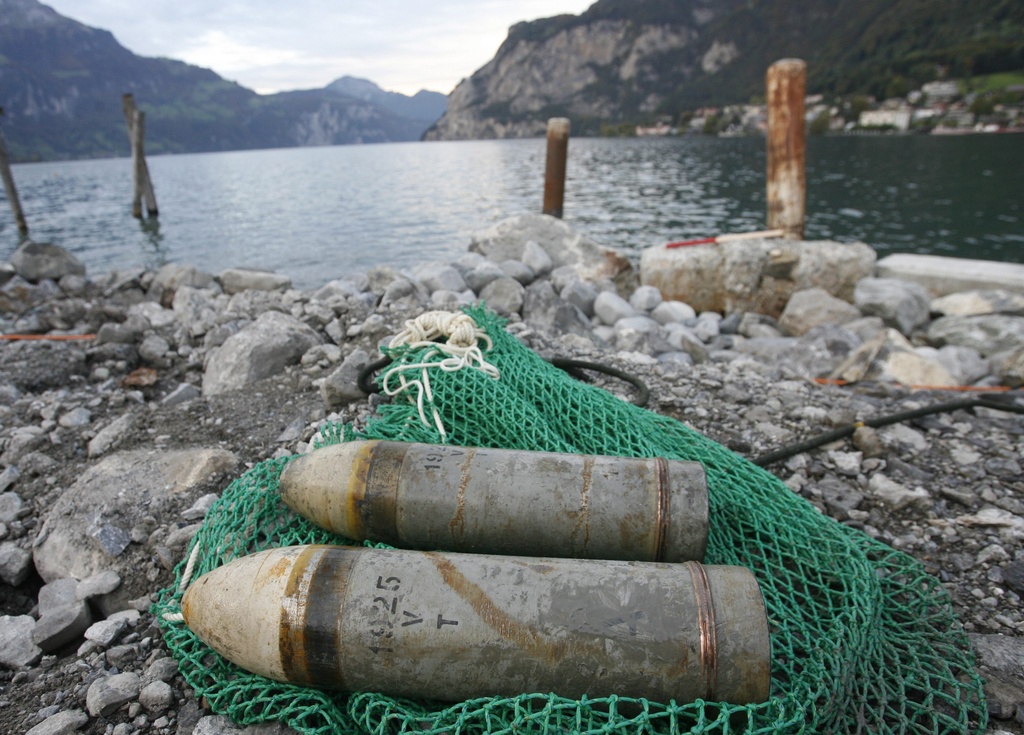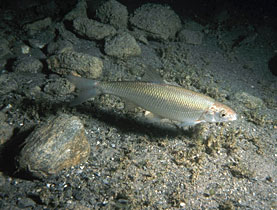Army munitions to remain underwater

Swiss army munitions dumped in lakes from the 1940s to the 1960s will not be retrieved as a recovery operation would be more dangerous than leaving them in place.
The defence ministry and the cantons involved confirmed on Friday that bringing up the old shells and other munitions would be a risky exercise for the local population and contractors, with possible environmental damage also a concern.
A 2008 report had already reached the same conclusions about what should be done with over 8,000 tons of potentially dangerous materials dumped at depths of up to 200 metres.
Most of the munitions came from factories in Thun in canton Bern and Altdorf in canton Uri. Around one third date back to the Second World War and were dumped in 1948 on government orders after the catastrophic explosions of stockpiles shortly beforehand, including one in Mitholz in the Bernese Oberland that killed nine people.
“We are convinced after ten years of investigations that removing the munitions from the lakes would be far too risky for the environment, for our drinking water and for people’s security,” Heinz Habegger, head of canton Bern’s water and waste management office, told a news conference.
Bringing up the old shells would involve digging through sediment, disturbing the ecosystem for years. It would also create disturbances on the surface, in particular noise.
Handling the munitions would also increase the risk of explosion, endangering the local population, fauna and environment. Vast zones of the lakes would be off-limits to navigation.
Environmental organisations such as Pro Natura, which were included in discussions with the ministry, have approved the plan after recommending the same option a few years ago.
Good condition
Investigations have shown the shells strewn across the lake beds appear to be in good shape. The munitions are covered by sediment, in some case up to two metres deep, which helps seal them in.
According to Habegger, there is nothing to indicate that they are leaking explosive substances.
“Any traces of explosives we have found didn’t come from the munitions in the lake, but from external sources such as construction sites or firing ranges in the mountains,” he told swissinfo.ch. “These are small amounts, about one 400th the authorised limit for these substances in tap water.”
The concentrations of explosives are also one hundredth to one thousandth what is found for pharmaceuticals and pesticides in those locations.
Habegger says that 400,000 people drinking water in the Aare valley can keep on turning on their taps without any fear.
Ongoing surveillance
The defence ministry has promised to keep the dump sites under observation for the coming years. “We take our responsibility seriously, which is why we will keep up the surveillance,” said the ministry’s secretary general, Brigitte Rindlisbacher.
The cantons will also be keeping an eye on the situation.
“We will keep on systematically monitoring the water quality until 2016, when we will decide on future steps,” added Habegger. “In the unlikely event explosive substances make their way into the water, we will know straight away.”
Costs will be shared between the defence ministry and the cantons, who are responsible for monitoring water quality.
One question remains open concerning Lake Thun. Whitefish there have suffered from various deformities, but the munitions, despite initial suspicions, are not the source of their troubles.
A five-year study published in 2008 showed that the plankton that the fish eat are leading to defects in around 40 per cent of the animals. But why it is causing this effect will probably only be revealed late this year when another study is completed.
There are an estimated 8,210 tons of munitions lying at the bottom of some of Switzerland’s biggest lakes.
Lake Thun is home to 4,600 tons, Lake Brienz to 280 tons and Lake Lucerne to 3,330 tons.
These munitions are strewn over the lake beds and covered in sediment measuring between 25 centimetres and two metres.
Shells and ammunition were dropped in Lake Thun until 1963 and until 1967 in Lake Lucerne.
Other lakes have been a dumping ground for the Swiss army or used for target practice.
Lake Walenstadt received weapons, Lake Alpnach gas masks, and barbed wire ended up in small lakes around the Gotthard Pass.
Military aircraft also crashed to a watery grave in various lakes.
The accident that caused three explosions and led to the destruction of the Mitholz underground ammunition storage facility in the Bernese Oberland took place on the night of December 19-20, 1947.
The explosion caused the destruction of several houses and the local railway station in the village, and killed nine people.
Almost 7,000 tons of ammunition were stored at the site, of which an estimated 3,000 blew up or burned.
The remaining ammunition was thrown out and spread around the storage facility along with secondary fragments.
(Source: Bakhtar Associates)

In compliance with the JTI standards
More: SWI swissinfo.ch certified by the Journalism Trust Initiative













You can find an overview of ongoing debates with our journalists here . Please join us!
If you want to start a conversation about a topic raised in this article or want to report factual errors, email us at english@swissinfo.ch.